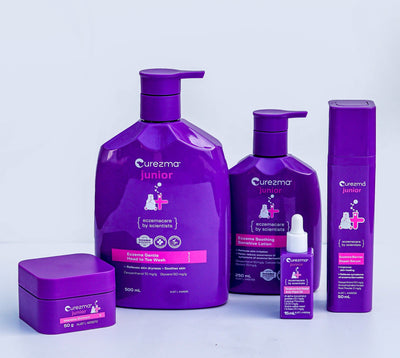3 Overlooked Tips for Managing Your Child's Eczema in Winter
Winter can be particularly challenging for children with eczema. The cold weather, dry indoor heating, and harsh winds can exacerbate symptoms, leading to more frequent flare-ups. Here’s a guide to help parents manage their child’s eczema during the winter months, focusing on often overlooked yet effective tips.

1. Embrace Oil-Based Moisturisers
Your child's skin barrier acts as a protective shield against bacteria, germs, and other environmental invaders. However, eczema can weaken this barrier, as can harsh winter elements. To keep your child’s skin barrier strong, it needs regular moisture to prevent irritants and allergens from entering.
“Moisturisers with a higher oil content, such as ointments, and specialised ingredients, such as ceramides, are especially helpful in repairing skin that has lost its water and lipid content,”
said Dr. Smita Aggarwal, board-certified dermatologist and paediatric dermatologist at Medical Dermatology Associates of Chicago.
Oil-based moisturisers help protect against moisture loss through the skin barrier, and ointments are especially beneficial to help lock in moisture when humidity falls.
For example, Curezma’s Barrier Repair Serum contains coconut oil, which has natural prophylactic (preventative) properties and barrier repair benefits. The high content of medium-chain fatty acids in coconut oil helps kill staph colonisation on the skin and provides strong broad-spectrum antibacterial properties. Additionally, Curezma's Intensive Ointment contains sunflower oil, which boosts ceramide production and has emollient and barrier repair properties. This combination makes the Barrier Repair Serum and Intensive Ointment a perfect winter duo for managing eczema.
2. Gradual Warming and Moisturizing
Coming in from the cold into a warm house can sometimes trigger eczema flare-ups due to the sudden temperature change and dry indoor air. To minimise this, warm your child's skin gradually.
Dr. Peter Lio, assistant professor of clinical dermatology and paediatrics at Northwestern University’s Feinberg School of Medicine, suggests,
“Taking a warm bath followed by a thick moisturiser to lock in the water can be incredibly soothing for your child’s cold, chapped skin.”
Always use lukewarm water and limit baths to 10 minutes to avoid drying out the skin further. Pat the skin dry with a soft towel and apply a moisturiser immediately to lock in moisture.
3. The Importance of Vitamin D
Winter means shorter days and less sunlight, which can reduce the body's production of vitamin D. Many eczema patients have a relative vitamin D insufficiency, which can worsen eczema symptoms.
Vitamin D helps modulate immune responses, suppress inflammation, and promote a stronger skin barrier. Dr. Lio typically recommends 4,000 IU per day for adults, 400 IU per day for infants and toddlers, and 1,000 IU per day for older children. Consult your physician or your child’s paediatrician before adding any supplements to your routine to determine the appropriate dosage.
In a small study of children ages 2–13 with eczema, 80% of those taking 1,000 IU of vitamin D per day for one month showed improvement in their symptoms. In another study with 30 participants, all of those taking 1,600 IU of vitamin D daily showed significant improvement in their eczema. Keep in mind, however, that too much vitamin D can be dangerous, so stick to doses recommended by your healthcare provider.
We hope these 3 tips help you find the best eczema care for your child during winter. If you haven't already tried Curezma we offer a full money back guarantee so you have nothing to lose giving us a go.
References:- National Eczema Association: Six Tips for Keeping Eczema Calm in Winter
- National Eczema Association: Three Eczema Tips to Help Keep Kids Cozy This Winter
- National Eczema Association: Get the Facts: Vitamin D
- National Eczema Association - Coconut Oil: https://nationaleczema.org/blog/get-the-facts-coconut-oil/








